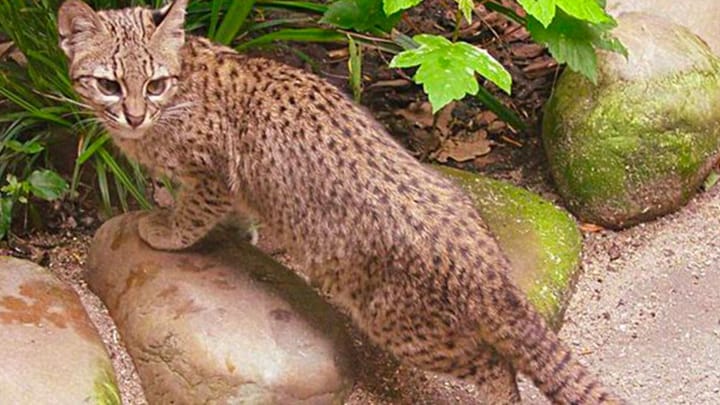Safari

Safaris are a new hybrid breed and only about 70 individuals exist in the world. They are the product of a cross between the domestic cat and the Geoffroy’s Cat, a Bolivian species of feline. Safaris are mysterious, little known and fascinating...
|
Life expectancy |
The {breedName} has a life expectancy of approximately 15 years |
|
Temperament |
|
|
Adult size |
Female
Between 16 and 18 in
Male
Between 16 and 18 in
|
|
Adult weight |
Female
Between 24 and 33 lb
Male
Between 24 and 33 lb
|
|
Coat colour
Given the breed’s rarity, no standard for their fur colour is recognised by the majority of feline associations. |
Black Brown White Red Cream |
|
Type of coat
Short |
Short |
|
Eye colour
Their eyes are yellow or green |
Green
Yellow
|
There is a high degree of similarity between the genome of several wild cat species, which makes hybridisation between domestic cats and some of their wild cousins easier. Several of them have the same number of chromosomes, often with identical structure.
Nevertheless, the Safari is the result of a cross between the domestic cat and the Geoffroy’s Cat, Leopardus geoffroyi. These cousin species are both part of the Felidae family and are sufficiently similar from a genetic point of view to produce viable hybrid offspring. However, the genome of the Geoffroy’s Cat has 36 chromosomes next to the domestic cat’s 38. Whereas Safaris, the descendants of this hybridisations, have 37 chromosomes themselves. This genetic variability between the two species makes crossing them more difficult and the process is laborious and complicated.
When choosing a cat of this breed, it is important to be meticulous with documentation and make sure to contact trustworthy breeders.
More details about the Safari
Safari: Origins and history
The Safari originates from the United States. The initial pairing of a Geoffroy’s Cat with a domestic cat occurred in a research lab in the seventies - the practice of breeding them came about in the decades that followed. Today, there are around 70 individuals registered by TICA (The International Cat Association).
Physical characteristics of the Safari
No official standard yet exists for this breed. However, we do know that they are short-haired, spotted tabby cats, and they always have the exotic look of a big cat.
Safari: Characteristics
Safari: Behaviour
Breed compatibility Safari
Safari: Purchase price
The purchase price of a Safari varies enormously from one kitten to another. Hower, as this breed is still very new, there is not enough date to set an average price for this cat. The price will therefore be high because of the breed’s rarity. The cat’s lineage, sex and age can also influence the cost. You should allow for at least £40 per month to meet their needs, by offering them a high quality diet and ensuring to keep them in good health.
Be wary of fraudulent breeders who deceptively try and sell cats of other breeds as Safaris.
Safari: Shedding
Light
These cats seem to lose little hair.
Safari: Grooming
Again, it’s difficult to offer a steadfast protocol for grooming, but for all domestic cats it’s recommended that you brush them on a regular basis.
Safari: Health
Their average life expectancy is probably around 15 years, but keep in mind that this is based on a small sample of individuals given the breed is relatively new.
For lack of comprehensive data, it’s difficult to determine the robustness of this breed, so we have given them 2 stars by way of an ‘average’ score.
The risk of feline obesity is influenced by a number of factors like age, environment, diet and the cat’s activity level. Since these cats are generally very energetic, their risks of becoming overweight are very low, as long as their requirements for physical activity are met.
Since this is a little-known breed, it’s difficult to give concrete advice on the physiological health of individuals. In any case, an annual medical check-up is recommended to ensure their health and wellbeing. What’s more, they can suffer from the same illnesses as non-hybrid domestic cats, particularly oral diseases.
No information is available on possible pairings with other cats. Certain hybrid breeds, like the Safari, sometimes have issues with reproduction, due to some individuals being infertile.
The Geoffroy’s Cat is protected by various regulations concerning the holding and reproduction of wild exotic species (including CITES Appendix 1).

